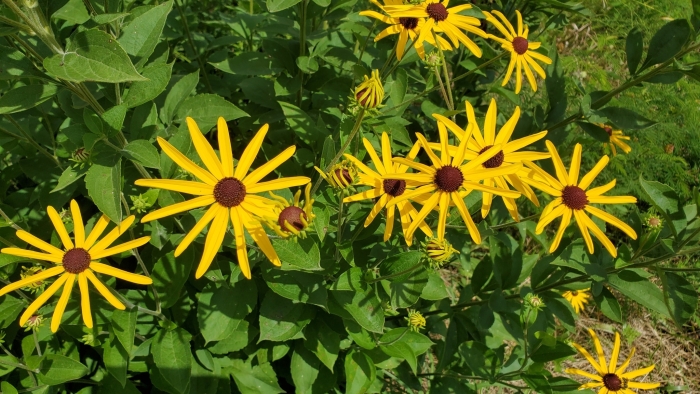Sweet Coneflower
(Rudbeckia subtomentosa)
Sweet Coneflower (Rudbeckia subtomentosa)
/
/

Lexi Destria
CC BY 4.0
Image By:
Lexi Destria
Recorded By:
Copyright:
CC BY 4.0
Copyright Notice:
Photo by: Lexi Destria | License Type: CC BY 4.0 | License URL: http://creativecommons.org/licenses/by/4.0/ | Rights Holder: Lexi Destria | Publisher: iNaturalist | Date Created: 2020-08-04T11:09:15-07:00 |












































Estimated Native Range
Summary
Rudbeckia subtomentosa, commonly known as Sweet Coneflower, is a deciduous perennial herb native to the tallgrass prairies and open woodlands of the Central United States. It typically grows to a height of 3-5 feet (0.9-1.5 meters) and a width of 1-2 feet (0.3-0.6 meters). The plant features a clumping form with branched stems and bears daisy-like flowers with yellow rays and a prominent, raised central cone that is brownish-purple, blooming from mid-summer to early fall. The flowers are highly attractive to pollinators and are quite showy, making them a favorite in wildflower gardens.
Sweet Coneflower is valued for its long blooming period, wildlife attraction, and the sweet vanilla scent of its foliage when crushed, hence the name "Sweet". It is commonly used in naturalistic plantings, perennial borders, and as part of pollinator gardens. This species thrives in full sun to part shade and prefers medium to moist soils with good drainage. While adaptable to a range of soil types, it flourishes in rich loamy soils. It is relatively low maintenance but can be susceptible to powdery mildew in humid conditions. Deadheading spent flowers can encourage additional blooming and prevent excessive self-seeding.CC BY-SA 4.0
Sweet Coneflower is valued for its long blooming period, wildlife attraction, and the sweet vanilla scent of its foliage when crushed, hence the name "Sweet". It is commonly used in naturalistic plantings, perennial borders, and as part of pollinator gardens. This species thrives in full sun to part shade and prefers medium to moist soils with good drainage. While adaptable to a range of soil types, it flourishes in rich loamy soils. It is relatively low maintenance but can be susceptible to powdery mildew in humid conditions. Deadheading spent flowers can encourage additional blooming and prevent excessive self-seeding.CC BY-SA 4.0
Plant Description
- Plant Type: Herb
- Height: 3-5 feet
- Width: 1-2 feet
- Growth Rate: Moderate
- Flower Color: Brown, Yellow
- Flowering Season: Summer, Fall
- Leaf Retention: Deciduous
Growth Requirements
- Sun: Full Sun, Part Shade
- Water: Medium
- Drainage: Medium, Fast
Common Uses
Bee Garden, Bird Garden, Butterfly Garden, Deer Resistant, Fragrant, Groundcover, Hummingbird Garden, Low Maintenance, Rabbit Resistant, Showy Flowers, Street Planting
Natural Habitat
Tallgrass prairies and open woodlands
Other Names
Common Names: Sweet Black-Eyed Susan, Prärierudbeckia
Scientific Names: , Rudbeckia subtomentosa, Centrocarpha subtomentosa, Centrocarpha triloba, Rudbeckia subtomentosa f. subtomentosa, Rudbeckia subtomentosa var. subtomentosa, Rudbeckia tomentosa,
GBIF Accepted Name: Rudbeckia subtomentosa Pursh